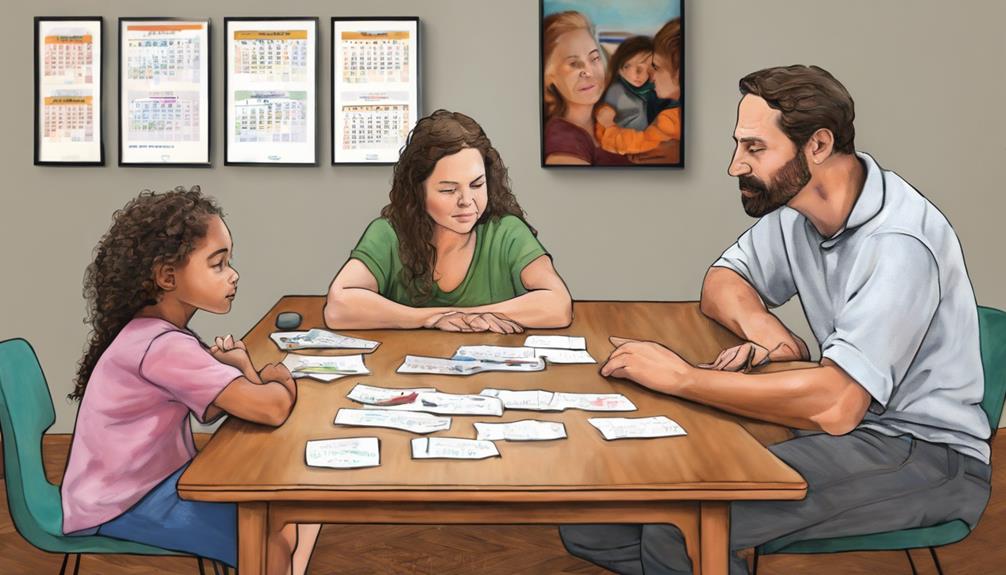Embarking on the complex journey of forging new connections with our children following a divorce is like navigating through unknown seas, where every tide of change presents both hurdles and possibilities.
The complexities and nuances that arise in these circumstances require a delicate balance and thoughtful approach. How can we ensure a smooth transition for our children while building meaningful connections in this new chapter of our lives?
Join us as we explore the intricacies of fostering healthy relationships with children post-divorce, delving into strategies that pave the way for emotional growth and stability in the family unit.
Key Takeaways
- Wait 9-12 months before introducing new partner to prioritize children's stability and security.
- Communicate openly with children, addressing feelings and fostering dialogue.
- Handle children's reactions by validating emotions, reassuring unchanged bonds, and prioritizing quality time.
- Establish blended family dynamics gradually, promoting inclusivity, unity, and empathy.
Timing of Introducing New Partner
When considering the timing of introducing a new partner after divorce, waiting 9-12 months is recommended to maintain a stable environment for children. It's crucial to prioritize the well-being of our children by ensuring they feel secure before we introduce them to a new partner. Kids need time to adjust to the changes that come with divorce, and rushing into a new relationship can add unnecessary complexity to their world. By waiting until we're in a committed relationship, we show our children that we value their needs above all else.
Introducing your new partner too soon after divorce can blur the lines for children and impact the parent-child relationship. It's essential to give kids the space and time they need to process the divorce before bringing someone new into their lives. By being mindful of the timing and considering the children's needs first, we can create a smoother transition and ensure that our new partner is welcomed into the family with open hearts.
Communication With Children

Navigating new relationships after divorce involves engaging in open and honest conversations with our children about our new relationship post-divorce. It's crucial to communicate openly with our children when introducing a new partner into their lives. By addressing their feelings and concerns, we can create a supportive environment where they feel heard and understood. Encouraging our children to ask questions and share their thoughts about our new partner helps them feel involved in the process and fosters a sense of transparency.
| Meeting Your New Partner | Handling Your Child's Feelings | Age-Appropriate Communication |
|---|---|---|
| Schedule a casual meeting to introduce your new partner | Actively listen and validate your child's emotions | Use language and explanations suitable for your child's age |
| Allow your child to observe interactions between you and your partner | Reassure your child of your love and support | Encourage questions and open dialogue |
| Be patient and give your child time to adjust | Provide stability and consistency in your relationship | Offer reassurance about the future |
Handling Children's Reactions
In handling children's reactions to introducing a new partner after divorce, it's essential to acknowledge and validate their potential negative emotions. Children may experience fears of being replaced or concerns about changes in the parent-child relationship. Reassuring them of the unchanged bond you share can alleviate these worries.
Prioritizing quality time with your children over nurturing the new relationship is crucial for maintaining stability during this transition. It's important to listen actively to your children's concerns and involve them in finding solutions to address their fears. Validating their feelings throughout this process is key to ensuring their emotional well-being is supported.
Establishing Blended Family Dynamics

Establishing blended family dynamics requires intentional efforts to build strong and harmonious relationships among all family members. When introducing a new partner into your children's lives, it's crucial to prioritize their emotional well-being. Let your kids meet your new partner gradually and in a safe space, ensuring they feel comfortable and respected throughout the process.
Being transparent about your relationship with your new partner in front of the kids can help normalize the situation and reduce any feelings of confusion or betrayal. In blended families, creating a sense of unity and inclusivity is key. Celebrating holidays together can be a wonderful way to bond and create lasting memories, fostering a deeper connection between all family members.
Acknowledge and address challenges openly, showing empathy and understanding towards each other's feelings. Remember, blending families takes time and effort, but with patience and love, harmonious relationships can blossom, making everyone feel like a valued part of the process.
Long-Term Relationship Considerations
When considering long-term relationship aspects post-divorce, it's crucial to prioritize the emotional readiness and stability of all involved, especially the children.
Taking time to establish a strong foundation with your new partner before introducing them to your children is essential for long-term success. Waiting for 9-12 months after the divorce to meet your new romantic partner can help ensure that the children are ready for this new love in your life.
It's important to talk to your kids about the new relationship and consider their comfort and feelings throughout the process. Rushing into introducing children to a new partner can lead to challenges in building trust and acceptance over time.
Frequently Asked Questions
At What Age Is a Child Most Affected by Divorce?
We believe children between 10 and 14 experience significant effects from divorce. Their emotional sensitivity during early adolescence can amplify the impact. Understanding their unique needs and providing support during this crucial stage is vital.
How Do You Navigate Dating After Divorce With Kids?
We understand the complexities of dating after divorce with kids. It's essential to proceed thoughtfully, prioritize children's emotions, and communicate openly with your ex. Waiting for a committed partnership before involving children ensures stability and support.
How Long Should You Wait Before Introducing Your Child to a New Partner?
We believe waiting for the right time is key. Rushing could stir up emotions. Consider your child's feelings first. Be patient. Let them adjust. Build trust. Their comfort matters most in this delicate dance.
When Should I Start a New Relationship After Divorce?
We should start a new relationship after divorce when we feel emotionally ready and have given ourselves time to heal. Rushing into a new relationship can be overwhelming. It's essential to prioritize our well-being first.
Conclusion
In conclusion, it's crucial to approach new relationships with children after divorce with patience and sensitivity. Research shows that children who witness their parents navigate new relationships with care and communication are more likely to adjust well to changes.
By prioritizing the emotional well-being of the children, establishing open communication, and allowing for gradual integration, we can create a supportive environment for them to thrive in post-divorce relationships.










